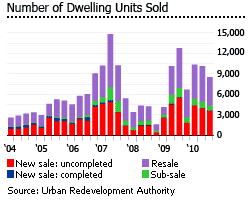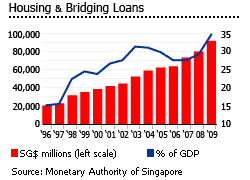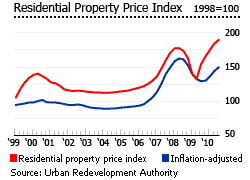Singapore's house price rises slowing, as government measures bite

In the second quarter of 2011, Singapore’s private residential property price index rose 2% q-o-q, after quarterly price increases of 2.2% in Q1 2011, 2.7% in Q4 2010, 2.9% in Q3 2010 and 5.3% in Q2 2010, according to the Urban Redevelopment Authority (URA).
- Non-landed property prices rose by 1.4% q-o-q in Q2 2011, compared to a 1.7% rise the previous quarter.
- Landed property prices rose by 3.6% q-o-q in Q2 2011, after a 3.9% q-o-q rise in Q1 2011.
To restrain the property bubble the government has taken a dual-pronged strategy - increasing land supply, and imposing market curbs. In January 2011, the government executed its 4th round of measures:
- Loan-to-value (LTV) ratios on second mortgages were lowered to 60% of the appraised value of the property
- The Seller’s Stamp Duty was raised, and more taxes on residential property transactions were introduced
In 2010, Singapore’s economy expanded by 14.5%, after experiencing a 0.8% contraction in 2009 due to the global crisis. In 2011, Singapore’s economy is expected to grow by 5.2%, according to the IMF. Due to a slump in manufacturing, manufacturing fell 5.5% in Q2 2011 from a year earlier, after seeing a 16.4% y-o-y growth in the previous quarter.
Property prices in Singapore are still rising by double-digit figures annually, but the price rises have now slowed for seven consecutive quarters. Property prices rose by 10.2% in the year to end-Q2 2011 – a significant from the rise of 38.2% during the year to Q2 2010.
The average price of high-end non-landed private properties was SG$2,269 (US$1,891) per sq. foot. In the first quarter of 2011, according to Savills Singapore, a real estate firm. On the other hand, the average price of super luxury residential homes was SG$3,417 (US$2,848) per sq. foot. over the same period.
The slowdown in house price rises is widely projected to continue:
- Savills Singapore expects property prices to remain stable in the coming months, rising by 1% to 3% in Q2 2011. In addition, overall monthly residential sales will likely stabilize at between 1,200 units to 1,500 units.
- Ong Teck Hui of Credo Real Estate expects the URA’s residential price index to rise by 5% to 7% in 2011.
- Png Poh Soon of Knight Frank has trimmed its forecast to 8% to 10% house price growth in 2011, slower than the earlier projection of 10% to 12%.
The overall figures conceal different price movements per property type.
For landed properties:
- Prices of detached houses surged by 3.3% q-o-q in Q2 2011 (vs. 4.1% in Q1 2011)
- Prices of semi-detached housed rose by 3.9% q-o-q in Q2 2011 (vs. 2.8% in Q1 2011)
- Prices of terrace housed rose by 3.8% q-o-q in Q2 2011 (vs. 3.9% in Q1 2011)
For non-landed properties:
- Prices of apartments rose by 1.8% q-o-q in Q2 2011 (vs. 0.8% in Q1 2011)
- Prices of condominiums rose by 1.2% q-o-q in Q2 2011 (vs. 2.1% in Q1 2011)
Anti-speculative measures
With limited land and resources, Singapore has one of the world’s most interventionist housing market policies. The government strictly controls and monitors the use of land and the allocation of housing units to citizens and other residents. The government also actively participates in almost all aspects of housing including planning, construction, and housing finance.
The government imposed anti-speculative measures in February 2010. It also announced an aggressive plan to increase land supply in May 2010.
In August 2010, the government tightened financing and restricted homeownership of flats provided by the Housing and Development Board (HDB). Another measure targeting the private homes market requires homeowners to pay a 3% stamp duty on the sale price of properties held for less than 3 years. In addition, the minimum cash payment was doubled to 10% for those already servicing another mortgage.
Then in October 2010, new curbs on foreign ownership of landed homes were unveiled, which involves raising the penalties for those found breaching the Residential Property Act.
These measures are on top of those released in September 2009:
- reinstating the Government Land Sales (GLS) Confirmed List in H1 2010, and replenishing the supply of Reserved List sites in the GLS;
- disallowing the Interest Absorption Scheme and interest-only loans; and
- non-renewal of assistance measures for property developers announced in the 2009 budget, when these expire in early 2010.
Sales plunged

In the 3rd quarter of 2010, the total sales transactions dropped by 16.1% q-o-q to 8,513 units, according to URA. The decline in sales was seen across the board.
- The number of uncompleted private residential property sold by developers fell by 10% q-o-q to 3,561 units in Q3 2010 while completed private residential property dropped by 1.3% q-o-q to 77 units
- Sub-sale fell by 20.1% q-o-q to 703 units over the same period
- Re-sale plunged by 20.3% q-o-q to 4,172 units in Q3 2010
Total sales transactions plunged by 33.2% in Q3 2010 from the same period last year.
In the 3rd quarter of 2010, there was a total supply of about 64,358 uncompleted units of private housing in the country, based on the latest figures released by URA.
Developed mortgage market, stable interest rates

Singapore’s mortgage market is one of the most developed in Asia. The size of the mortgage market was approximately 34.5% of GDP in 2009, up from 29.1% of GDP in 2008.
The total amount of outstanding housing loans rose by 14.9% to around SG$91.4 billion (US$71.1 billion) in 2009, from about SG$79.6 billion (US$61.95 billion) in the previous year, according to the Monetary Authority of Singapore (MAS).

Interest rates are relatively stable in Singapore, as monetary policy is implemented through the exchange rate, i.e. the foreign exchange rate is used to adjust economic growth and inflation.
The prime lending rate has been 5.38% since January 2008. The interest rate on housing loans has been at a record-low of 5.23% since July 2010, down from 5.73% imposed from June 2006 to Feb 2008. Low and stable interest rates have provided security for borrowers, even though variable interest rate mortgages dominate the market.
Small rental market

With the most successful home-ownership program in the world, the rental sector in Singapore is small, mostly serving expatriates. The local private rental sector is much smaller, because the HDB still owns about 81% of all rental units.
In the 3rd quarter of 2010, rents of private residential properties rose by 3.6% q-o-q, after a 5.9% rise in Q2 2010, according to URA. Over the said period, rents of non-landed properties:
- rose by 3.6% q-o-q in Core Central Region (CCR)
- increased by 3.7% q-o-q in the Rest of Central Region (RCR)
- rose by 3.6% q-o-q in Outside Central Region (OCR)
The average monthly rent of high-end non-landed residential properties tracked by Savills Singapore was SG$5.15 (US$4) per sq. ft. in the 2nd quarter of 2010.
Rent increases have typically lagged property price changes in Singapore, leading to low yields. For instance, residential prices rose almost 100% between 1990 and 1996, but rents rose by only 52%.
However in the most recent boom, the sudden influx of expatriates led rents to rise faster than property prices. From Q2 2004 to Q2 2008, the residential rental index rose by 82% while the price index rose by only 58%. When the residential price index started falling, the rent index also fell but at a slower rate (24.9% vs. 18.6%, respectively from Q2 2008 to Q2 2009).
As the economy recovered quickly from the global crisis, both prices and rents accelerated. House prices rose by 22.9% in Q3 2010 from a year earlier, while rents rose by 15.6% over the same period.
Nevertheless, rental yields remain relatively low in Singapore. Global Property Guide research shows that rental returns in Singapore range from 2.9% to 4.3%, with smaller units earning higher yields. The average rental yield of 3.5% in May 2009 was unchanged from last year.
Foreign buyers are important
Singapore has a total population of about 5 million, of which around 64% are Singaporean citizens, about 11% are permanent residents, and the remaining 25% are expats. The country’s population has the sixth-highest percentage of foreigners in the world. About 42% of the population of Singapore are foreigners.
Singapore has experienced an influx of expatriates in the past years, and some foreigners have preferred to buy rather than face escalating rentals, especially if they are going to be in Singapore for more than a couple of years.
Foreign buyers contributed to strong house price increases recently. In the first half of 2010, foreign purchases accounted for about 25% of the total residential property sales transactions in Singapore, according to Savills Singapore. Malaysians, Indonesians, Chinese, and Indians were the biggest foreign property buyers in the country.
Stellar economic growth

Singapore is heavily dependent on international trade, particularly on the concept of entrepot trade—purchasing raw goods and refining them for re-export. The Port of Singapore is one of the world’s busiest ports. Exports, especially in electronics and chemicals, and the services sector are the country’s main sources of revenue.
The Singaporean economy is expected to expand by about 13% to 15% in 2010. In the 3rd quarter of 2010, annual GDP growth rate was high at 10.3%, but still slower than the spectacular 19.6% growth recorded in the previous quarter. However, according to the Ministry of Trade and Industry, the slowdown in GDP growth was "an expected correction from the exceptional growth in the first half of the year". In addition, GDP growth was expected to return to a slower but more sustainable pace.
The economy contracted by 1.3% in 2009 due to the global crisis, but has since rebounded quickly. From 2004 to 2007, the average GDP growth rate was 8.45% per year. Then in 2008, economic growth slowed sharply to 1.8%.
In September 2010, the unemployment rate was 2.1%. The unemployment rate among Singaporean citizens and permanent residents slightly dropped to 3.1% in Q3 2010, from 3.2% in the previous quarter.
The annual inflation rate accelerated to a 20-month high of 3.7% in September 2010, due to higher costs of transport, food, and housing, according to Singapore Department of Statistics. In 2009, the inflation rate was just 0.6%.
Inflation is projected to be 2.5%-3% in 2010 and 2%-3% in 2011, based on the latest forecast by MAS.